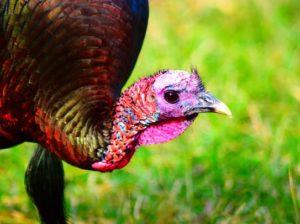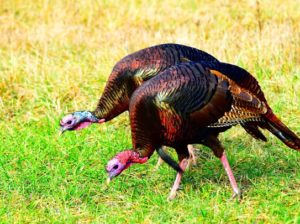By Ashlyn Halseth

Photo by Cody Scarborough
When proposing a national symbol for the United States, many of the founding fathers looked towards the Bald Eagle for their intimidatingly strong beaks and wings built for soaring; however, a myth has circulated in American culture that Benjamin Franklin had a different idea. Wild Turkey or Meleagris gallopavo, were thought to have been Franklins’ muse with adult males having the charismatic face coloration of red, white, and blue. This myth has been disproven since, and his “grand idea” was ultimately shot down, but Wild Turkeys still play a large part in both America’s ecosystem and Thanksgiving dinner.
Adult males, or gobblers, are known to get this red, white, and blue face coloration when strutting, a practice used to attract a female for breeding. This coloration is universal throughout the Wild Turkey subspecies; however, some morphological characteristics vary based on regional location. Wild Turkeys are located in all 48 continental US states and Hawaii. In comparison to Georgia turkeys, Wild Turkeys located in the southwest have lighter feathers. Female turkeys will have lighter feathers than males and lack iridescence, regardless of location, to help camouflage them while brooding.
Females will lay anywhere from 4-18 eggs a year, with the average range being 10-15 eggs. Instead of laying all the eggs in one day, the female turkeys will lay one egg a day and start the incubation period after the last egg is laid. Wild Turkeys will not build a nest, like most songbirds, but will nest on the ground at the base of a tree or a shrub. This is common within their order, Galliformes, and sometimes will occur in their family Phasianidae. Other birds within this taxonomic family include the Ring-necked Pheasant, Prairie-chickens, Ptarmigan, and Grouses.

Photograph by Cody Scarborough
Habitat loss and poor hunting regulation lead to a fall in the Wild Turkey population in the late 19th century and early 20th. Restoration efforts began quickly to restore the bird’s numbers and by 1940, the Wild Turkey range has expanded back to its original range. As of 2017, the Wild Turkey population was estimated at around 7 million within the US. This is only 2.9% of the entire meat turkey population, there are 242 million, also found within the US. Meat turkeys are the same species as Wild Turkeys but are considered a subspecies, Meleagris gallopavo domesticus. While they generally look similar, the Wild Turkeys are adapted to survive in the wild, while meat turkeys are bred to be larger. Wild Turkeys are generally timider than meat turkeys and are quieter to hide from predators. They also have more “dark meat” within their wings and breasts to help circulate the area for flight.
Wild Turkeys also consume a more diverse diet than meat turkeys, because of their need to scavenge rather than eat an artificial diet. Wild Turkeys are omnivores, eating a diverse diet of berries, grass blades, bulbs, insects, snails, amphibians, reptiles, and sometimes crabs. In order to locate some of their prey species, Wild Turkeys will scratch leaf litter to reveal yummy grubs. They are also crepuscular, meaning that they are most active during the morning and evening where they can escape predators more easily and avoid becoming the next Thanksgiving meal.
Sources:
Bailey, Austin. 2019. “8 Facts You Didn’t Know About Turkeys” Heifer International. https://www.heifer.org/blog/animals/facts-about-turkeys.html
Kaufman, Kenn. “Wild Turkey: Meleagris gallopavo.” Audubon. https://www.audubon.org/field-guide/bird/wild-turkey
“Wild Turkey.” The Cornell Lab: All About Birds. https://www.allaboutbirds.org/guide/Wild_Turkey/lifehistory#

Recent Comments